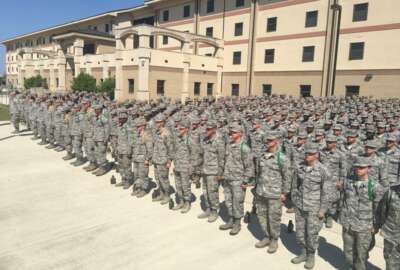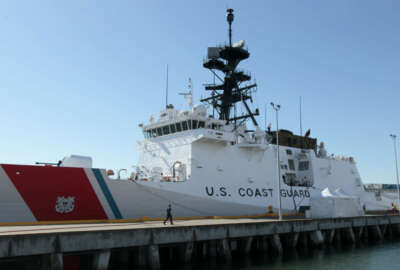She rescued this sea-faring federal group from sinking under its own culture
For service members or civilians aboard the nation's ships and planes, nothing is worse than a culture of assault, bullying and sexual harassment. Yet those were...
For service members or civilians aboard the nation’s ships and planes, nothing is worse than a culture of assault, bullying and sexual harassment. Yet those were widespread on the craft operated by the National Oceanic and Atmospheric Administration. Federal Drive with Tom Temin‘s guest set about fixing a toxic culture. Now she’s a finalist in this year’s Service to America Medals program. She is Rear Adm. Nancy Hann, the director of NOAA’s Commissioned Corps and director of its Marine and Aviation Operations.
Interview Transcript:
Tom Temin So what was going on when you took over? I mean, what kind of reports were you getting and what was NOAA trying to do here?
Nancy Hann So we’re getting reports from across our workforce of bullying, harassment behavior, and we united with our workforce to figure out what was going on, why it was going on, and what we could do as a team to address it. And really what we’re aiming for and what we’ve been working towards is a respectful workplace so everybody can show up and feel safe physically, mentally, emotionally to do the taxing job that we asked them to do and that the nation depends on.
Tom Temin And let’s back up for a moment. The commissioned corps at NOAA is a uniformed type of force and it crews the vessels that NOAA operates. Tell us about the extent, the number of people and how it all works and how it comes to be a uniformed service.
Nancy Hann So the NOAA Corps is one of the eight uniformed services in the United States, and our primary responsibility is to operate NOAA’s 15 ships and soon to be 10 aircraft. And we work alongside our civilian counterparts that are professional mariners and civilians, the engineers, the stewards, the deck department, the mechanics, the technicians. So as a team in this work force, we prepare the ships and aircraft, we operate them, and we make sure that we’re collecting data for the nation that informs everything from fishery quotas each year to hurricane forecasts.
Tom Temin And these people are trained by NOAA or are they from the Maritime Academy? What’s their background to get to NOAA as a commissioned corps member?
Nancy Hann So we have a very diverse workforce. We have the NOAA Commissioned Corps. We have a total of six personnel systems. We have five unions or five collective bargaining agreements. And we come from all corners, all sectors. So everything from experience in the maritime commercial fleet to fishing vessels, to maritime academies to prior government and private sector work. Our workforce literally comes from every corner of the nation and we come together in these unique environments to operate our ships and aircraft.
Tom Temin And how many are there of you?
Nancy Hann We have just over 330 officers, and we have just about 400 professional mariners. Overall, we have over a thousand people in our workforce. But the people who actually go to sea and fly the aircraft are about 600 at any given time.
Tom Temin So it’s a pretty small workforce compared to the Coast Guard or the Navy or something like that. So a few bad apples can really kind of hurt the whole bushel then, can’t they?
Nancy Hann Absolutely. So it’s a small workforce which to your point, can have really detrimental impacts within an operational unit within a ship, within an aircraft, within an operational center. The good news is we’re a small team, so we are nimble and that’s really played to our benefit in making these workplace improvements is that we can come together as a team. We train as a team in person. We have these conversations in person, and that’s really driven the change.
Tom Temin Give us a sense of the timeline. When did all this take place? When did these reports come in and what was your job at the time, or was it the job you have now?
Nancy Hann So it was actually two jobs ago. So I was the chief of staff for marine and aviation operations. And I really started to get the sense of what was going on and working with the workforce to understand why it was happening, where were them payments to the process and addressing what was going on, and then followed that through my time as a deputy director and then now the director. We’ve really kind of taken this bull by the horns and tackled it aggressively, I’d say, for the last five years.
Tom Temin Sure. And just give us a little bit more sense of what it was that was going on. Was it primarily sexual assault? Was it simply bullying male, female? Both ways. I mean, what was actually going on?
Nancy Hann So I don’t know if the word fortunately is the right word, but this was pretty much in the realm of harassment, bullying. We weren’t seeing assault. I think there had been one or two assault cases in that timeline. But it was everything from hazing, when new employees would come on board to longstanding employees, you would make people scientist or our own crew feel uncomfortable, be limited in the way they could perform their job. So we really tackled this at the grassroots. It starts everything from how we welcome new employees or visiting scientists on our platforms to what type of jokes are appropriate, to make people feel included on the team. And then certainly touching of any kind is not allowed and not permitted. So we’ve really tackled this from every corner. We call it respectful workplace, because that’s where it all starts, is how people treat each other day in and day out. And when that’s left untended, that’s what results in the harassment and assault. So we’ve really tackled it at the grass roots, knowing that that left unchecked is that chain of events that we’re all so familiar with in the operational world that leads to a devastation.
Tom Temin We we’re speaking with Rear Adm. Nancy Hann. She’s director of the Commissioned Corps and director of marine and aviation operations at NOAA. And she’s also a finalist in this year’s Service to America Medals Program. And according to the citation for your award, you also got rid of a few people. You took them right out of there and kind of cleaned up that way.
Nancy Hann We have. So when we set about really addressing this aggressively, we recognized three main pillars we had to address. First with training. We had to make it very clear to people what was tolerable and what was not tolerable. And that started with our training, not showing people PowerPoints or videos, but we actually did case studies based on cases that occurred within our work environment, within our workforce. We did training in-person. We had really uncomfortable conversations with people to understand what the problem was and how were we in the situation that we were and make it really clear what was and was not tolerable, what levels of conduct were expected. We also worked closely with our managers to make them understand they had a role in this. If someone brought an allegation to them, it wasn’t a choice to pass it on or not. They have an obligation to bring it forward and we have an obligation to investigate it. The third pillar was investigations. So at the time we didn’t have a way to thoroughly and quickly look into allegations. We do now. We have a contractor assigned to us. He’s a previous FBI investigator. He’s very experienced in operational environment. So he’s required to be on scene 48 hours from notification when we ask him. And he’s done that several times. So there’s something occurring on a ship and you pull into the dock and he’s there waiting for you, he is going to find out what’s going on on that ship or in that workplace. And then we’re swiftly going to take personal actions. And to your point, sometimes that’s involved removal, sometimes that’s involved pretty significant suspensions. But if you are not following the rules of our conduct, there will be consequences. And that’s very well known within our workforce.
Tom Temin And the unions generally go along with this because sometimes they can be a resisting force to that kind of change.
Nancy Hann We’ve done this in partnership with the union. So we’ve been clear from the beginning what the challenge is, what the goal is, and that the workforce has been part of this change. We have not kind of dictated them what to do because that would not be successful. We’ve had them be owners in what is a respectful workplace look like. What is their role and responsibility in that? How are they going to affect that change? So they have been active participants and the unions want a good workplace for their members. They have an expectation. We have an expectation. So we have that in common.
Tom Temin And how do you measure progress in an area like this? Is it simply fewer reports or are there other ways to tell? Maybe mission effectiveness improves in some manner?
Nancy Hann That’s a really good question, Tom, because just having less reports is not a good indicator, right? That can mean people are scared to report, that can mean they are fearful of retribution and reporting. So we’ve looked at this in a few key ways. Number one, we actually expected an increase in reporting when we put the proper structure in place. And that’s exactly what happened. We had more reporting. In the last few years, the number of reports have gone down. But what’s really important with the number going down is what is the severity of reports coming forward. And what we’re seeing as people are coming forward in much lower level actions. So at the beginning of that chain of events, they’re coming forward and having conversations and expressing concern at a much lower level. That’s key. The number alone is not key, the level of reporting, when people are reporting, what they’re reporting is key because, one, they feel safe reporting it. They know something’s going to happen. Something will happen with those allegations. I’ve also looked at safety, so I’ve told our workforce there is nothing more impactful to safety than a respectful workplace. We’re flying airplanes into hurricanes. We’re operating ships in the Bering Sea with 40 foot waves. Not having good communication among your crew is the most threatening thing to safety. And we’re already doing dangerous work. We can’t have this be present. So I’ve tracked safety trends, safety numbers. We do our own fleet inspections. So I talked to the chief of that division and frequently I say, what does it look like? What are your inspectors seeing? Is the crew all participating? Do they know their systems? Do they feel safe to operate those systems and tell you if they have concerns? And the answer is yes. So we’ve seen a significant change in our safety posture, both in numbers and how the interaction of the crew has expanded. So I watch it in several mediums. I talk to the leaders on our ships like do you feel like you’re empowered to take action if someone brings you allegation of a bad apple to use your words, do you feel empowered to make a decision whether that’s bringing a ship to port immediately, removing that crew member from your ship, taking personal action? And they say, yes, they absolutely do. So there’s several factors that I keep very close tabs on to make sure that our plan is working. Our plan is having a positive result.
Tom Temin Do you ever wish you could be underground boss, and kind of spend a couple of days or something in one of the units or aboard one of the planes and just kind of observe? Of course, most of them would probably recognize you.
Nancy Hann Yeah, I do. Sometimes I get to spend some time on a ship or visit our centers. But I do wish I could more to make sure that I’m staying connected with the hard work that people are doing every day. There’s a lot of sacrifices. People are away from their families for months and months at a time. And they’re making a lot of sacrifices to collect this data for the nation. So it’s always important for me to stay grounded and realize what the challenges are that they’re facing and what the sacrifices are that they’re making and how committed they are to collecting this data.
Copyright © 2024 Federal News Network. All rights reserved. This website is not intended for users located within the European Economic Area.
Tom Temin is host of the Federal Drive and has been providing insight on federal technology and management issues for more than 30 years.
Follow @tteminWFED






